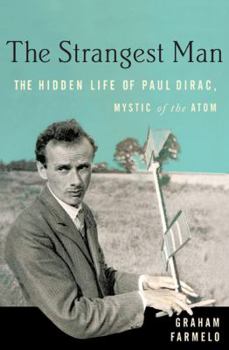The Strangest Man: The Hidden Life of Paul Dirac, Mystic of the Atom
Select Format
Select Condition 
Book Overview
Paul Dirac was among the greatest scientific geniuses of the modern age. One of Einstein's most admired colleagues, he helped discover quantum mechanics, and his prediction of antimatter was one of... This description may be from another edition of this product.
Format:Hardcover
Language:English
ISBN:0465018270
ISBN13:9780465018277
Release Date:August 2009
Publisher:Basic Books (AZ)
Length:539 Pages
Weight:1.88 lbs.
Dimensions:1.8" x 6.4" x 9.3"
Age Range:18 years and up
Grade Range:Postsecondary and higher
Customer Reviews
4 ratings
Fascinating
Published by Thriftbooks.com User , 15 years ago
Paul Dirac possessed one of the most profound intellects in history, virtually single handedly creating the fields of relativistic quantum mechanics and quantum field theory. But his extraordinarily introverted personality and complete lack of interest in anything outside theoretical physics have left him essentially invisible to the public eye. Even physicists familiar with his stunning achievements know almost nothing about his private life. Hence, Graham Farmelo's wonderful new biography is most welcome indeed. Carefully researched and very well written with an engaging style, the text flows like a well crafted novel. Not only does this work provide valuable insights into the nature and, often tragic, life of "the strangest man" (as Bohr was said to have called him) but conveys something of the atmosphere in the academic centres (Cambridge, Göttingen, Copenhagen) where the dramatic events in the early history of quantum mechanics took place. Perhaps inevitably in a work of this length, Mr. Farmelo occasionally stumbles. He asserts that the great Pakistani physicist Abdus Salam was a student of Dirac when, in fact, Salam did his Ph.D. under Paul Matthews and Nicolas Kemmer. And he incorrectly attributes the first explanation of the Lamb shift to Richard Feynman and Julian Schwinger when the honour belongs to Hans Bethe. Such errors, however, do not adversely impact the significance and enjoyment of the book. Indeed, if a genuine criticism can be applied, it is in the uselessness of attempting to explain Dirac's scientific contributions to laymen. This is hardly the fault of Mr. Farmelo. It is simply that quantum field theory cannot be understood without the requisite higher mathematics. Fortunately, such diversions are mercifully few and do not affect the flow. This book is heartily recommended to anyone interested in the history of science and the development of a great mind.
Nobel Laureate, Fan of Cher
Published by Thriftbooks.com User , 15 years ago
Paul Dirac was one of the founders of quantum theory. He fused quantum theory and the special theory of relativity and, in the process, provided a reason for suspecting that there is such a thing as anti-matter. Dirac died in 1984. Given that (a) the work for which he is remembered was all done by 1931, (b) his work was rather technical, and (c) he had no life apart from his work, how has Graham Farmelo managed to write a 500-page biography and, what's more, to include only five equations, four of which have nothing to do with physics? It's a neat trick. First, Farmelo gives us more than a biography. He gives us a history of quantum theory. Second, he tells us about people associated with Dirac, many of whom did have a life outside physics. Finally, Farmelo has a gift for expressing technical ideas simply, compactly, in mere words--words anyone can understand. For example, his account of the infinities that plagued quantum field theory could not be simpler. The infinities are important to Farmelo's story because, if Pierre Ramond can be believed, it is because of them that Dirac was convinced, as he approached death, that his life had been a failure. Farmelo speculates that Dirac may have been autistic. Strange he certainly was. It's hard to picture this great mind, absorbed week after week in Cher's television show. But, then, this was a fellow who thought Wittgenstein was "awful" because he talked too much. Farmelo suggests that Dirac's truth-via-beauty philosophy is an afterthought, that it did not guide him in his important work. (This matters in biography, though not in physics. In physics, experimenters will always have the last word, and their detectors are indifferent to philosophies.) Farmelo shows us how very lucky Dirac was. Had Dirac not stumbled into physics he might well have shared his brother's fate.
A great and unusual scientific biography
Published by Thriftbooks.com User , 15 years ago
Most biographies of scientists are uninteresting about their lives and half impenetrable, to the lay reader, about their science. Farmelo's book about this extraordinary man, who was until recently as unknown to the outside world as he was revered among the physics community, breaks with this dreary tradition. It's a wonderfully readable piece of original scholarship that catches the man's weird, unhappy yet oddly serene personality and also explains clearly the reasons for his enormous stature as a scientist. If you want an insight into a truly 'beautiful mind', this is the place to find it. And if you have the smallest interest in quantum physics and the ideas that have shaped our world, the book is essential.
A joy to read
Published by Thriftbooks.com User , 15 years ago
This engaging and fascinating biography of one the world's greatest, though mostly unknown, physicist requires no knowledge of physics to tempt the layperson interested in learning about an odd brilliant character and his impact on the world of science. You also get a wonderfully clear picture of Britain in the 20th century. The writing is clear and highly intelligible even when describing Dirac's remarkable breakthroughs in quantum mechanics. I highly recommend this book.






